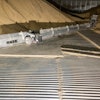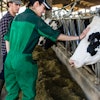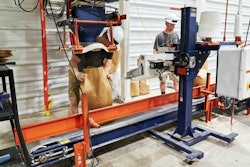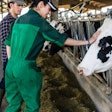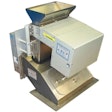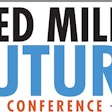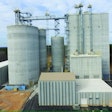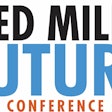
More small, medium feed manufacturers are investing in automation as a means to survive and thrive in today’s labor market
Finding and retaining reliable employees has challenged the animal feed industry pre-dating the“Great Resignation.”农村的操作有一个有限的,with unique challenges in attracting a stable workforce. As new technologies come online and others improve, feed manufacturers invest in automation to increase production and improve their efficiency and profitability. However, trends in the labor market have prompted increased interest in robotic solutions.
At the end of the line, manual palletizing positions are especially difficult for feed producers to fill. The work is difficult and repetitive — often in an uncomfortable environment — and can take a physical toll. Here, robotic palletizing systems have become a popular and efficient solution, one that alleviates stress of trying to fill the role.
Today, in the face of critical post-COVID labor shortages, more feed producers are investing in robotic palletizing systems to survive and strengthen their operation long term.
Feed Strategy sat down with Joe Natale,Premier Tech’ssales manager for the animal feed sector in the U.S. and Western Canada, to discuss how robotic palletizing systems are helping feed manufacturers cope withrural labor shortagesand position their businesses for future growth.
Seventy percent of Premier Tech’s North American feed mill applications are used to handle finished feed, and 30% involve feed additives, premixes and ingredients.
Q&A with Premier Tech’s Joe Natale
Feed Strategy: Any notable trends or shifts in the demand for robotic palletizing systems since the COVID pandemic?
Joe Natale, Premier Tech sales manager:In rural areas, I see a huge emphasis on labor. Feed is not the most glamorous of industries and a lot of times the work is difficult. It’s not an air-conditioned environment, it’s not dust free. Quite a few customers are competing for labor with big distribution warehouses or something like that, which is an air-conditioned, easier environment.
COVID has made [labor challenges] even stronger because there just doesn’t seem to be a whole lot of folks willing, in general, to work their butt off. Even before [COVID], I would say, there was an emphasis on labor shortages. In a rural environment, we don’t have access to a huge pool of labor. There may not be public transportation to the mill, there’s a few factors there that play into it just not being conducive to having a lot of folks available or readily available labor.
When you talk about palletizing, specifically, you’re talking about people who must lift 40 or 50 pounds or more, so you’re sort of further reducing the labor pool. So, you know, it’s challenging to establish that spot in your plant. First, you don’t have a whole group to choose from and then you’re further restricted because it’s not easy. I get a lot of people saying, “We try to staff and by day two they’ve called in sick or they just don’t come in anymore or they call and say I can’t make it, then they’re sort of gone.”
I’ve routinely heard that story. Feed mills just can’t staff, especially in a palletizing role. Unfortunately, it’s not an easy role to fill, and then to keep that person there, keep them motivated. It’s a mundane task.
Feed Strategy: Are you seeing an uptick in new customers putting in robotic systems for the first time or more existing customers expanding or upgrading their equipment? What’s the breakout?
Natale:Our customers break into three groups: national companies with multiple mills, small regional producers [with multiple mills], and the single-mill customers.
The large national customers have a plan in place, and the plan is to continue to automate and replenish the palletizing systems and bagging systems that they have. Automation is already there, they’re very keen to it, they’re very aware of it, they know it, they have it, and they’re just continuing the trend. It’s usually a replacement of equipment or a new site they are going to automate.
Then there’s the regional mill group, a feed customer with five to 10 plants. They might be somewhat down the road on automation. They might be replacing new systems, but they’re doing the same as the bigger groups.
Then there’s the single-owner mills. Here, we’ve seen quite a few install fully automatic systems. They have a business opportunity and they’ve said, “You know what, if we stick to the current way we do business without automation, we’re not going to be successful.” I would say they have been more in the manual area, that are making the jump to automation. I think that’s because they just don’t see any other way. They’re tired of doing business the other way, which is manual labor that’s not available anymore. Towns are smaller, labor is hard to find, but there’s an opportunity there for them to do some new business, perhaps, or expand their business and the only way they can do it is by automation.
The smaller player may not have been interested five years ago, but now there’s some opportunity out there. They’re business owners, a bit more entrepreneurial, and they know they’re not going to get there with manual labor. They recognize that, and then they factor the equipment into how they’re going to do business.
Feed Strategy: Would you say that COVID has accelerated their willingness to make these investments or is this the direction things would have been going anyway?
Natale:是的,毫无疑问。可能不会给你任何groundbreaking there. No one has ever said we have an abundance of labor — even five years ago — it wasn’t like, we have so many people looking to do this job so you’re not going to help me. It was more like, you know what, we can’t find people and palletizing is one part of that.
Palletizing is mundane, it’s repetitive, it’s unsafe — you want to have as little operator involvement as possible so having mechanization makes sense, right? It’s more efficient and it’s just going to be better long term. A machine is going to work better than a human operator, but again, it is always application driven.
Feed Strategy: When you talk to potential customers, what do you identify as the three key benefits of robotic palletizing systems?
Natale:First, I would say safety. There are obviously risks with manual palletizing. Companies are concerned about their operators, whether it’s their personal safety, which should be the case, or more from a financial perspective, you know, risk mitigation. Health insurance claims and premiums can be quite costly.
Then I would say, a dramatic improvement in packaging efficiency. There’s a certain physical component to palletizing by hand. You can only do so much for so long at a certain rate. The operator is limited in how many bags they can do a minute — not to mention the other human factors like sick days, breaks or unmotivated employees. To improve or increase a facility’s bagging capacity, you have to have your back-end palletizing improved through automation or by putting more labor on the line.
And, third, consistency. As producers become less reliant on manual labor, they can achieve more consistent results. With automation, you know you can make your production quota that day when you can turn on the machine. So it’s a lot more consistent in that regard.
Feed Strategy: How many positions can robotic palletizing system eliminate?
Natale:There’s some direct replacement of the operator doing the actual palletizing task and it sort of depends on the application itself. Some applications, like finished feed, will run faster so it’s more of a volume play versus feed ingredients where you might want to be much more accurate and the emphasis is getting a high volume of product out the door.
If you’re running faster, there’s a direct replacement of an operator. If there’s one operator, if there are two operators, depending on how fast the bags are coming … I’ve seen some sites where there’s a group sort of sitting around and they sort of take turns because they come quick when they come.
You can package more effectively, with greater speed and more effectively. The existing operator(s) can be reassigned and given different tasks around the facility.
I would say the other thing to think about or consider is that having an automated system, whether it’s bagging and/or palletizing, will it help potentially reduce employee turnover, which reduces the acquisition cost of labor and increases retention. They can create a better work environment so people don’t leave.
Feed Strategy: What’s the average return on investment (ROI) for one of these systems?
Natale:Pre-COVID, ROI was anywhere between six-to-eight-month ROI all the way up to maybe 36 months.
But I want to say that, honestly, with COVID, it’s almost been a situation of business continuity versus ROI. It’s kind of hard to stay in business if you can’t sell your product. Not ROI be damned, but kind of. The emphasis sort of slides down a little bit because they’re not able to get the people in there anymore. I think that business continuity is a big thing right now.
All equipment manufacturer lead times are historically long right now because there are so many folks who are realizing that to keep their business going and the one way to do that is with automation.
The ROI, for sure, is an important thing. Companies try to get there within 24-to-36-month window, but honestly, some of our customers are just saying, we need this, because it’s not going to work otherwise.
Feed Strategy: Looking at future technologies, how do you think robotics — in handling or otherwise — may evolve? And what kinds of possibilities or opportunities are there for feed mill applications?
Natale:Robotics have been incorporated into more the front end of the packaging process in bagging. There’s actually little robots now inside the bagger to effectively move the bag from the selling point to the selling point. And we use the robot simply because we were using it on the palletizing side and said “Wow, this thing really works well, it’s effective. It’s repeatable. You know, there’s not that many moving parts, it’s good. It’s maintenance friendly. So put it in the bagger.” We’re seeing this trend already.
The next trend maybe using robotics in depalletizing applications, meaning having a palletizer take bags off a pallet to maybe feed a mixing system or another type of process equipment in the feed mill.
Maybe front-end automation systems for replacing empty bags in the bagging system. Right now, there’s still an operator there monitoring it, but we’re removing tasks for them so that they can focus on performing higher-level functions.
The idea of having robots throughout the packaging line is not uncommon and potentially upstream on the process side as well.
Feed Strategy: What’s the outlook for robotic systems in the next decade?
Natale:There’s a big demand for robotic integration and applications in feed mills. I don’t see it slowing down. Especially for those single mill-type customers — either you automate or you’re going to be gone. Either you jump on board or you’re going to be selling your mill to another group and getting out of the feed business.
For more information on Premier Tech and its products, visitPremier Tech’s Feed & Grain Buyers Guide profile.
Announcing the Feed Mill of the Future digital supplement
WATT’s feed brands Feed Strategy and Feed & Grain magazines join forces to launch the monthly Feed Mill of the Future digital supplement. Each edition aims to provide animal feed industry stakeholders with forward-looking content, market insights and a spotlight on the leading-edge technologies shaping the global feed industry of tomorrow.
Subscribe today!https://bit.ly/3dWzow7



